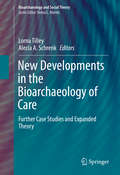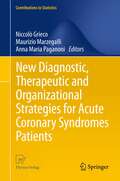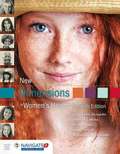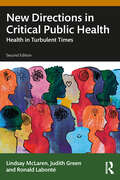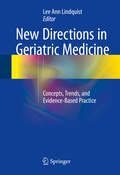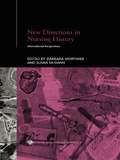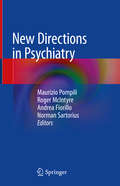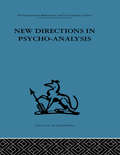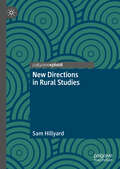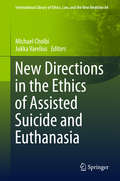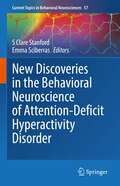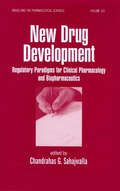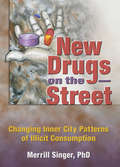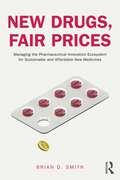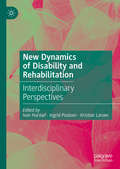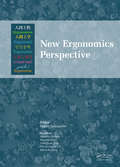- Table View
- List View
New Developments in the Bioarchaeology of Care
by Lorna Tilley Alecia A. SchrenkNew Developments in the Bioarchaeology of Care evaluates, refines and expands existing concepts and practices in the developing field of bioarchaeological research into health-related care provision in the past. Evidence in human remains that indicates an individual survived with, or following, a serious pathology suggests this person most likely received some form of care from others. This observation was first made half a century ago, but it is only in the last five years that health-related caregiving has been accepted as a topic for bioarchaeology research. In this time, interest has grown exponentially. A focus on care provides a dynamic framework for examining the experiences of disease and disability in the past - at the level of the individual receiving care, and that of the community providing it. When caregiving can be identified in the archaeological record, bioarchaeologists may be able to offer unique insights into aspects of past lifeways. This volume represents the work of an international, diverse, cross-disciplinary group of contributors, each bringing their own particular focus, style and expertise to analyzing past health-related care. Nineteen chapters offer content that ranges from an introduction to the basic 'bioarchaeology of care' approach, through original case studies of care provision, to new theoretical perspectives in this emerging area of scholarship. This book creates a synergy that challenges our thinking about past health-related care behaviors and about the implications of these behaviors for understanding the social environment in which they took place.
New Developments on Computational Methods and Imaging in Biomechanics and Biomedical Engineering (Lecture Notes in Computational Vision and Biomechanics #999)
by Paulo Rui Fernandes João Manuel R. S. TavaresThis book gathers selected, extended and revised contributions to the 15th International Symposium on Computer Methods in Biomechanics and Biomedical Engineering (CMBBE2018), and the 3rd Conference on Imaging and Visualization, which took place on 26-29 March, 2018, in Lisbon, Portugal. The respective chapters highlight cutting-edge methods, e.g. new algorithms, image analysis techniques, and multibody modeling methods; and new findings obtained by applying them in biological and/or medical contexts. Original numerical studies, Monte Carlo simulations, FEM analyses and reaction-diffusion models are described in detail, together with intriguing new applications. The book offers a timely source of information for biologists, engineers, applied mathematicians and clinical researchers working on multidisciplinary projects, and is also intended to foster closer collaboration between these groups.
New Diagnostic, Therapeutic and Organizational Strategies for Acute Coronary Syndromes Patients
by Maurizio Marzegalli Niccolò Grieco Anna Maria PaganoniThis book collects several contributions, written both by statisticians and medical doctors, which focus on the identification of new diagnostic, therapeutic and organizational strategies in order to improve the occurrence of clinical outcomes for Acute Coronary Syndromes (ACS) patients. The work is structured in two different parts: the first one is focused on cooperative project mainly on statistical analysis of large clinical and administrative databases; the second one faces the development of innovative diagnostic techniques, with specific reference to genetic and proteomic, and the evolution of new imaging techniques for the early identification of patients at major risk of thrombotic, arrhythmic complications and at risk of poor revascularization.
New Dimensions In Women's Health (Seventh Edition)
by William Alexander Linda Lewis Alexander Judith H. Larosa Helaine BaderExtensively revised and updated with the latest statistics and developments in the field, New Dimensions in Women's Health, Seventh Edition provides a modern and comprehensive look at the health of women of all cultures, races, ethnicities, socioeconomic backgrounds, and sexual orientations. Written for undergraduate students studying health education, nursing, and women's studies, the text provides women with the critical information needed to optimize their well-being, avoid illness and injury, and support their overall health. Each chapter presents in-depth coverage of an important aspect of women's health and examines the contributing epidemiological, historical, psychosocial, cultural, ethical, legal, political, and economic influences. NEW TO THIS EDITION!- NEW - 17 new Animations can be found in the Navigate 2 eBook (free with every new print copy of the text)- NEW - Includes new material on healthcare reform and its implications for individual women and the country as a whole- NEW - Includes a new section on electronic cigarettes and vaping, as well as their impact on public health- NEW - Provides new tips and strategies for individuals who wish to quit smoking, reduce problem drinking, and quit illicit drug use- NEW - Incorporates a new section on the abuse and misuse of prescription and over-the-counter drugs- NEW - Includes a new section on dissociative disorders, including common forms of these disorders, how they can occur, and their effects on the psyche- Expanded discussion of STI risk for LGBT populations and how to reduce risk- Expanded discussion regarding gender identity, transgender, and gender neutralThe new digitally enhanced Seventh Edition is available with Navigate 2 Advantage Access which includes an interactive eBook, informative animations, labeling exercises, audio clips, practice activities and assessments.
New Directions In Conservation Medicine: Applied Cases Of Ecological Health
by Peter Daszak Richard Ostfeld A. AguirreIn recent years, species and ecosystems have been threatened by many anthropogenic factors manifested in local and global declines of populations and species. Although we consider conservation medicine an emerging field, the concept is the result of the long evolution of transdisciplinary thinking within the health and ecological sciences and the better understanding of the complexity within these various fields of knowledge. Conservation medicine was born from the cross fertilization of ideas generated by this new transdisciplinary design. It examines the links among changes in climate, habitat quality, and land use; emergence and re-emergence of infectious agents, parasites and environmental contaminants; and maintenance of biodiversity and ecosystem functions as they sustain the health of plant and animal communities including humans. During the past ten years, new tools and institutional initiatives for assessing and monitoring ecological health concerns have emerged: landscape epidemiology, disease ecological modeling and web-based analytics. New types of integrated ecological health assessment are being deployed; these efforts incorporate environmental indicator studies with specific biomedical diagnostic tools. Other innovations include the development of non-invasive physiological and behavioral monitoring techniques; the adaptation of modern molecular biological and biomedical techniques; the design of population level disease monitoring strategies; the creation of ecosystem-based health and sentinel species surveillance approaches; and the adaptation of health monitoring systems for appropriate developing country situations. New Directions of Conservation Medicine: Applied Cases of Ecological Health addresses these issues with relevant case studies and detailed applied examples. New Directions of Conservation Medicine challenges the notion that human health is an isolated concern removed from the bounds of ecology and species interactions. Human health, animal health, and ecosystem health are moving closer together and at some point, it will be inconceivable that there was ever a clear division.
New Directions in Critical Public Health: Health in Turbulent Times
by Judith Green Lindsay McLaren Ronald LabonteIn an era where debates about public health research, policy, and practice are central to the wider socio-political discourse, this invaluable volume brings together key themes from the last 15 years of critical scholarship in and of public health.The book provides both empirical examples and the conceptual tools for rethinking the role of public health in society, challenging the familiar biomedicalized and individualized discourse that has dominated throughout the COVID-19 pandemic. Divided into nine chapters, it covers key topics such as complex systems of health determinants, evidence-making in public health, and the role of corporate actors and philanthropists. Reframing the field through local and global political lenses, New Directions in Critical Public Health: Health in Turbulent Times also integrates interdisciplinary perspectives to provide a truly holistic overview of this rapidly evolving area.It will interest not only students and scholars of public health and the health sciences more widely, but also those in the fields of sociology, political and development studies, and economics.
New Directions in Geriatric Medicine
by Lee Ann LindquistThis book is designed to present the clinical geriatric trends within general internal medicine and family practice, which practitioners often encounter in caring for their older adult patients. Chapters focus on increasingly difficult clinical decisions that practitioners have to make in caring for older adults, who often experience medical complications due to memory loss, physical disability, and multiple chronic conditions. Written by experts in geriatric medicine, each of these chapters start with the most up-to-date clinical geriatric research and provide specific examples or case studies on how to use this information to address the clinical needs of older adult patients. In addition, there is a set of concise "take-home points" for each chapter that are easy to commit to memory and implement in clinical care of aging patients. As the only book to focus on current trends in geriatric research and evidence-based eldercare practice, Clinical Trends in Geriatric Medicine is of great value to internists, family practitioners, geriatricians, nurses, and physician assistants who care for older adults.
New Directions in Nursing History: International Perspectives (Routledge Studies in the Social History of Medicine #Vol. 22)
by Barbara Mortimer Susan McGannThis collection of essays reflects the current interdisciplinary and international nature of the history of nursing scholarship. Covering a range from the eighteenth to the twentieth century, this book draws on research from eleven different countries to address: the issues of professionalism within nursing the social and ethical issues which are woven into the relationship between the nurse/midwife and her patient/client the trans-cultural dimensions nurses create when they move from one culture to another and the recent developments in historiography.
New Directions in Psychiatry
by Norman Sartorius Andrea Fiorillo Maurizio Pompili Roger McIntyreThis book focuses on hot issues faced by clinicians in everyday clinical practice, and provides in-depth analyses of both met and unmet needs in the management of psychiatric disorders. It has been repeatedly shown that the needs of patients, relatives, the community at large and those of the governmental bodies only partially overlap. For instance, patients in their families are more concerned about quality of life, treatment, autonomy, and independent living; whereas governmental stakeholders are typically more concerned about relapse prevention and reduction of hospitalizations. As such, a volume bridging the gap between theoretical notions and practical understanding of patients’ untreated aspects of their psychiatric disorders is much needed. Instead of focusing on traditional descriptions of psychopathology and diagnostic criteria, the volume guides readers to core problems for each topic, taking into account new approaches in the classification of mental disorders as proposed by DSM-5. It elaborates on much-debated controversial problems such as the assessment and treatment of psychomotor agitation, and non-adherence to treatment that impacts on the psychiatric context. With its unique approach, this volume appeals to anyone with an interest in the field, including researchers, clinicians, and trainees.
New Directions in Psycho-Analysis: The significance of infant conflict in the pattern of adult behaviour
by Melanie Klein Paula Heimann R E Money-KyrleTavistock Press was established as a co-operative venture between the Tavistock Institute and Routledge & Kegan Paul (RKP) in the 1950s to produce a series of major contributions across the social sciences. This volume is part of a 2001 reissue of a selection of those important works which have since gone out of print, or are difficult to locate. Published by Routledge, 112 volumes in total are being brought together under the name The International Behavioural and Social Sciences Library: Classics from the Tavistock Press. Reproduced here in facsimile, this volume was originally published in 1955 and is available individually. The collection is also available in a number of themed mini-sets of between 5 and 13 volumes, or as a complete collection.
New Directions in Public Health Care: A Prescription for the 1980's
by Cotton M. LindsayThis volume is a revised edition of The Institute for Contemporary Study's report on national health insurance. It includes an analysis of legislation currently before Congress; an examination of hos-pital cost increases and cost containment; an in-vestigation of the politics of the National Health Insurance which asks if any major interest group involved in health care wants increased competi-tion; new research on both the NHS in Britain and Canada's relatively recent experiments with full NHI; an update on public health care; a considera-tion of the relationship between health and health care; a discussion of the subsidy of health care; and an analysis of the market for medical care and the effects of an NHI on the market for physicians.
New Directions in Rural Studies
by Sam HillyardUsing theory and method, this book seeks to critique and illuminate rural matters. Rural issues are tenacious and contested, as we continue to value the green and pleasant land, but in a rose-tinted way. The opening chapter provides a contextualising discussion of the new ways rurality has been conceptualised. Critical debates by leading scholars in recent years have expressed concern about the direction of travel inside rural areas and also with associated academic disciplines. These are overviewed and evaluated, as are the general trends in rural scholarship. This chapter then frames subsequent chapters on substantive areas of rural studies – both benign and contested. The subsequent chapters unpack specific issues through original case studies, illuminating the contemporary rural. They are the green wellbeing zeitgeist, narrowed to focus upon gardening, and at the other extreme the more emotive issue of country sports and live quarry game shooting. A third and final substantive chapter offers new empirical evidence of a rural coastal community experiencing acute healthcare needs. Offering original case studies that illuminate and inform new theoretical ideas around the rural, this book is essential reading for academics and students across disciplines interested in rural matters.
New Directions in Third Wave Human-Computer Interaction: Volume 1 - Technologies (Human–Computer Interaction Series)
by Michael Filimowicz Veronika TzankovaAs the first extensive exploration of contemporary third wave HCI, this handbook covers key developments at the leading edge of human-computer interactions. Now in its second decade as a major current of HCI research, the third wave integrates insights from the humanities and social sciences to emphasize human dimensions beyond workplace efficiency or cognitive capacities. The earliest HCI work was strongly based on the concept of human-machine coupling, which expanded to workplace collaboration as computers came into mainstream professional use. Today HCI can connect to almost any human experience because there are new applications for every aspect of daily life. Volume 1 - Technologies covers technical application areas related to artificial intelligence, metacreation, machine learning, perceptual computing, 3D printing, critical making, physical computing, the internet of things, accessibility, sonification, natural language processing, multimodal display, and virtual reality.
New Directions in the Ethics of Assisted Suicide and Euthanasia
by Michael Cholbi Jukka VareliusThis book provides novel perspectives on the ethical justifiability of assisted dying. Seeking to go beyond traditional debates on topics such as the value of human life and questions surrounding intention and causation, this volume promises to shift the terrain of the ethical debates about assisted dying. It reconsiders the role of patient autonomy and paternalistic reasons as well as the part proposed for medical professionals and clinical ethics consultation in connection with assisted dying, relates the debate on assisted dying to questions about organ-donation and developments in medical technology, and demonstrates the significance of experimental philosophy in assessing questions of assisted dying. This book is ideal for advanced courses in bioethics and health care ethics.
New Directions in the Ethics of Assisted Suicide and Euthanasia (The International Library of Bioethics #103)
by Michael Cholbi Jukka VareliusThis book provides novel perspectives on ethical justifiability of assisted dying in the revised edition of New Directions in the Ethics of Assisted Suicide and Euthanasia. Going significantly beyond traditional debates about the value of human life, the ethical significance of individual autonomy, the compatibility of assisted dying with the ethical obligations of medical professionals, and questions surrounding intention and causation, this book promises to shift the terrain of the ethical debates about assisted dying. The novel themes discussed in the revised edition include the role of markets, disability, gender, artificial intelligence, medical futility, race, and transhumanism. Ideal for advanced courses in bioethics and healthcare ethics, the book illustrates how social and technological developments will shape debates about assisted dying in the years to come.
New Discoveries in the Behavioral Neuroscience of Attention-Deficit Hyperactivity Disorder (Current Topics in Behavioral Neurosciences #57)
by Emma Sciberras S Clare StanfordNew Discoveries in the Behavioral Neuroscience of Attention Deficit Hyperactivity Disorder reviews the latest developments in preclinical and clinical research of Attention Deficit Hyperactivity Disorder. As well as updating key chapters that were included in an earlier edition, this volume includes some new topics that are attracting a great deal of interest and point the way to new and promising directions for future research. The chapters follow five main themes: Current perspectives on the clinical profile of ADHD and its treatment, common co-occurring conditions, neurobiological studies examining brain function and genetics, animal and in vitro studies, and future directions. This combination of topics emphasises the translational relevance and validity of preclinical research so as to enable a better understanding of ADHD and to highlight the promising strategies for developing new treatments.
New Drug Approval Process (Drugs and the Pharmaceutical Sciences)
by Richard A. GuarinoThe thoroughly revised Fifth Edition of New Drug Approval Process supplies readers with the latest global changes that affect pharmaceutical product approval and influence how new products are researched and marketed.Updated chapters include:advances in international regulatory requirements, including ICH guidelines and harmonizationa step-by-step
New Drug Development
by J. Rick TurnerNew Drug Development: Second Edition provides an overview of the design concepts and statistical practices involved in therapeutic drug development. This wide spectrum of activities begins with identifying a potentially useful drug candidate that can perhaps be used in the treatment or prevention of a condition of clinical concern, and ends with marketing approval being granted by one or more regulatory agencies. In between, it includes drug molecule optimization, nonclinical and clinical evaluations of the drug's safety and efficacy profiles, and manufacturing considerations. The more inclusive term lifecycle drug development can be used to encompass the postmarketing surveillance that is conducted all the time that a drug is on the market and being prescribed to patients with the relevant clinical condition. Information gathered during this time can be used to modify the drug (for example, dose prescribed, formulation, and mode of administration) in terms of its safety and its effectiveness. The central focus of the first edition of this book is captured by its subtitle, 'Design, Methodology, and Analysis'. Optimum quality study design and experimental research methodology must be employed if the data collected--numerical representations of biological information--are to be of optimum quality. Optimum quality data facilitate optimum quality statistical analysis and interpretation of the results obtained, which in turn permit optimum quality decisions to be made: Rational decision making is predicated on appropriate research questions and optimum quality numerical information. The book took a non-computational approach to statistics, presenting instead a conceptual framework and providing readers with a sound working knowledge of the importance of design, methodology, and analysis. Not everyone needs to be an expert in statistical analysis, but it is very helpful for work (or aspire to work) in the pharmaceutical and biologics industries to be aware of the fundamental importance of a sound scientific and clinical approach to the planning, conduct, and analysis of clinical trials.
New Drug Development for Known and Emerging Viruses (Methods & Principles in Medicinal Chemistry)
by Raimund Mannhold Jörg HolenzDiscusses how to fight Ebola, SARS Corona, and other known or emerging human viruses by building on the successes in antiviral therapy of the past decades Written by leading medicinal chemists from academia and industry, this book discusses the entire field of antiviral drug discovery and development from a medicinal chemistry perspective, focusing on antiviral drugs, targets, and viral disease mechanisms. It provides an outlook on emerging pathogens such as Ebola, Zika, West Nile, Lassa, and includes a chapter on SARS Coronoavirus-2 causing the present pandemic. New Drug Development for Known and Emerging Viruses describes the discovery and development process for antiviral agents for different classes of viruses and targets based on the experiences from the nine human viruses for which approved drugs are on the market (HIV, HCV, Influenza, RSV, HBV, HPV, HCMV, HSV, and VZV). It covers the properties and potential of 20 classes of currently approved antivirals, including combination drugs, and looks at novel antiviral strategies against emerging viruses. Covers the entire field of antiviral drug discovery and development Addresses the need for antiviral drugs to combat major health threats such as Ebola, Zika, West Nile, and SARS Coronavirus-2 Summarizes the successes of the past 15 years in developing ground-breaking medicines against 9 major human viruses, both from the medicinal chemistry and the pharmacological angle Discusses practical and strategic challenges in the drug discovery and development process, including screening technologies, latency, and toxicity issues New Developments in Antiviral Drugs is an important book for medicinal chemists, pharmaceutical chemists, virologists, and epidemiologists, and will be of great interest to those in the ;pharmaceutical industry and public health agencies.
New Drug Development: Regulatory Paradigms for Clinical Pharmacology and Biopharmaceutics (Drugs and the Pharmaceutical Sciences)
by Chandrahas G. SahajwallaHighlighting key points from the latest regulatory requirements, New Drug Development helps those new to the world of pharmaceutical development understand regulatory steps, reduce cost by avoiding unnecessary trials, and attain guidance through each step of the drug approval process. This volume acquaints readers with procedures that determine the
New Drugs on the Street: Changing Inner City Patterns of Illicit Consumption
by Merrill SingerLearn the public health implications of shifting drug-related risks among the inner city poorInner city drug use behavior shifts and changes, leaving past drug treatment programs, drug prevention efforts, health care provisions for drug users, and social service practice unprepared to effectively respond. New Drugs on the Street: Changing Inner City Patterns of Illicit Consumption tackles this problem by presenting the latest ethnographic and epidemiological studies of emerging and changing drug use behaviors in the inner city. This one-of-a-kind resource provides the latest research to help readers reconceptualize ways to think about today&’s drug use to more effectively address the growing problem.Unless public health and social service professionals keep in step with the shifting patterns of drug behaviors, drug use epidemics will inevitably unfold. New Drugs on the Street reveals the latest drug use practices of the poor in the inner city, with a concentration on the research in African-American and Latino populations. Each chapter gives an in-depth look at the use of various psychotropic drugs most recently gaining popularity, along with the surprising reemergence of PCP. The rampant use of ecstasy in the rave scene is explored, along with the effects of its heavy use, its after-effects, the likelihood of poly-drug mixing, and dangerous sex risk behaviors. Urban youth drug networking is examined in detail. The alarming use of embalming fluid mixtures is discussed, along with the disturbing public health implications of its use. The illicit use of narcotics analgesics (NA) like Vicodin and other pain killers is also explored, including the unclear association between NA use and Hepatitis C. A final chapter presents the latest information on Haitian youth and young adults in Miami, Florida, with ethnographic background to illustrate the reasons for drug use in this and other ethnic minorities. This valuable source is extensively referenced and includes several helpful tables to clarify research data.New Drugs on the Street examines: ecstasy diverted pharmaceutical painkillers PCP embalming fluid narcotics analgesics (NA) drug use dynamics the changing street drug scene new drug combinations new drug-involved populationsNew Drugs on the Street reveals the nature and direction of the latest drug use and is essential reading for health professionals in the health social sciences, public health, nursing, and substance abuse fields that deal with low income, ethnic minority, and inner city populations.
New Drugs, Fair Prices: Managing the Pharmaceutical Innovation Ecosystem for Sustainable and Affordable New Medicines
by Brian D. SmithNew Drugs, Fair Prices addresses the important question of how we might get the innovative new medicines we need at prices we can afford. Today, this debate is impassioned but sterile. One side calls for price controls, discounting their impact on investment in innovation. The other points to miraculous new therapies, disregarding their affordability and social inequity. This polarized argument creates more heat than light, threatening the social contract between the industry and society on which pharmaceutical innovation depends. This ground-breaking book takes a wholly new perspective on the issue and raises the debate to a more informed and productive level. Drawing on interviews with more than 70 experts across the pharmaceutical innovation world and combining a diverse literature from scientific, political, economic and business domains, it describes how a sustainable and affordable supply of new medicines is possible only by balancing pharmaceutical innovation’s complex, adaptive ecosystem. By considering how each of the ecosystem’s seven habitats work and interact with the others, it makes a comprehensive set of recommendations for achieving that ecosystem balance. The core message of New Drugs, Fair Prices is important to anyone who ever has needed or will ever need a medicine: we can have a sustainable supply of new medicines that are both innovative and affordable if we manage the pharmaceutical innovation ecosystem intelligently.
New Drugs: An insider's Guide to the FDA's New Drug Approval Process for Scientists, Investors and Patients
by Lawrence T. FriedhoffDrug development, the processes by which a chemical compound becomes a “drug” and is approved for sale by the FDA and European and Asian regulators, is not for the faint-of-heart or the shortsighted. Designing and monitoring studies, obtaining and analyzing scientific data, and reconciling clinical results against the ethical constraints and regulatory guidelines of government agencies, requires a complex interaction of in-house specialists and academic and commercial consultants worldwide. Scientific, technical, and tactical considerations play out in an environment where a balance must be struck between the often-competing interests of the corporation, its investors, government regulators, and the safety and well being of intended patients. All the while, dwindling patent protections impose an ever-contracting timeframe for success. Written to be accessible to a wide audience, NEW DRUGS provides a thorough, succinct, and practical understanding of these drug-development processes. If you’re involved in the pharmaceutical industry, NEW DRUGS will provide scientific and management tools to increase the likelihood of regulatory approval at each phase of your compound’s development. If you’re a patient or consumer, NEW DRUGS will enable you to intelligently discuss medications with your health-care provider and empower you to make informed decisions at the pharmacy. If your portfolio, rather than your health, makes you an interested observer of the fortunes of this critical sector of the US economy, NEW DRUGS will help you to decode press releases and annual reports, so that you can recognize and invest in well-run companies with promising products.
New Dynamics of Disability and Rehabilitation: Interdisciplinary Perspectives
by Ivan Harsløf Ingrid Poulsen Kristian LarsenThis collection provides a broad coverage of recent changes in medical and vocational rehabilitation in Northern Europe. It presents analyses that cut across health sciences, medical sociology, disability studies and comparative welfare state research. Through this interdisciplinary perspective, the book explores the changing roles of patients, caregivers, professionals and institutions, and the wider implications of these changes for social inequalities in health. What obstacles do different groups of patients encounter when negotiating the complex chains of medical and vocational services? Who decides regarding references to specialized treatments, and the provision of comprehensive and coordinated services, and different types of benefits and material support? What is the importance of the resources that patients and caregivers bring to bear in the rehabilitation process?
New Ergonomics Perspective: Selected papers of the 10th Pan-Pacific Conference on Ergonomics, Tokyo, Japan, 25-28 August 2014
by Sakae YamamotoNew Ergonomics Perspective represents a selection of the papers presented at the 10th Pan-Pacifi c Conference on Ergonomics (PPCOE), held in Tokyo, Japan, August 25-28, 2014.The first Pan-Pacific Conference on Occupational Ergonomics was held in 1990 at the University of Occupational and Environmental Health, Japan. The main theme of the PPCOE 1990
